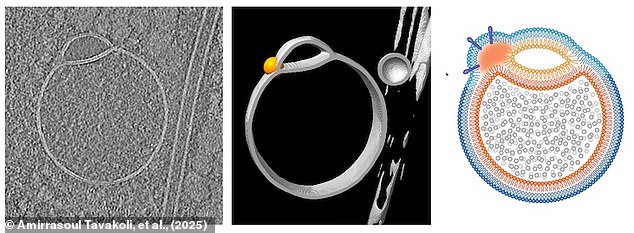
Scientists Stunned by Unprecedented Discovery of Hidden Cellular Structure in Human Cells
Scientists Discover New Cellular Structure: The Hemifusome
A groundbreaking discovery has revealed a previously unknown structure within human cells called the hemifusome. Measuring 200–400 nanometers in diameter (500 times thinner than a human hair), these tiny organelles act as cellular “recycling centers,” managing waste and material transport. Their discovery, led by researchers at the University of Virginia, opens doors to understanding genetic disorders like Hermansky-Pudlak syndrome, which causes albinism, vision loss, and lung disease.
[Image: Hemifusomes (HF) resemble two bubbles fused at the edges, visualized via cryo-electron tomography.]
How They Were Found
To detect these minuscule structures, scientists used cryo-electron tomography. Samples were flash-frozen at -150°C (-240°F), sliced thinly, and imaged with electron microscopes. This technique preserved the cell’s natural state, revealing hemifusomes’ unique architecture—defying previous assumptions about membrane stability.
Function: Cellular "Loading Docks"
Hemifusomes generate vesicles, sac-like structures that act as cellular “mixing bowls” or “delivery trucks.” Dr. Seham Ebrahim, co-author of the study, compares hemifusomes to a “loading dock,” where vesicles transfer cargo. These vesicles package proteins, recycle cellular components, and may store chemicals.
[Image: Vesicles produced by hemifusomes resemble blister-like sacs, crucial for transporting materials.]
Surprising Stability
A key finding was the hemifusion diaphragm—a thin membrane connecting vesicles and hemifusomes. Once thought too fragile to function, this structure keeps vesicle contents separate yet connected, like adhered water balloons. This stability enables efficient material transport, challenging prior scientific models.
Medical Implications
Disruptions in hemifusome function may underlie diseases involving cellular waste management. By studying these organelles, researchers aim to develop therapies for conditions like Hermansky-Pudlak syndrome. As Dr. Ebrahim states, “Understanding how hemifusomes behave in healthy versus diseased cells could lead to revolutionary treatments.”
[Image: Cryo-electron tomography captures hemifusomes’ intricate structure, critical for cell health.]
Why It Matters
Discovering a new organelle is rare, and hemifusomes’ role in cellular logistics reshapes our understanding of biology. Future research will explore their interactions with other cell components and their dysfunction in diseases. This breakthrough highlights the power of advanced imaging technologies in unlocking cellular mysteries.
Key Stats About Cells
- First cells appeared ~3.8 billion years ago.
- Human cells: 0.001–0.003 cm in diameter.
- 50–70 billion cells die daily in humans.
- Red blood cells live ~120 days.
(Word count: ~600)


